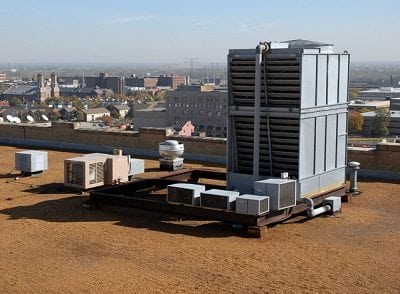Due to factors like a lack of space or a preference to keep an HVAC system out of sight, some are placed on the rooftop. Obviously, the high location could make some maintenance tasks trickier, but the tips below, combined with the professional advice of a technician, should help you steer clear of trouble.
Don’t Rush Through the Installation
If a rooftop system Is installed incorrectly, it may start malfunctioning in only a few months. Make sure your technician is familiar with how to install your rooftop unit, and that any problems that arise get addressed promptly.
Keep Fans Functional
When a rooftop HVAC system gets installed, a pulley alignment check and belt adjustment should be scheduled for three weeks later. Furthermore, those same preventative measures need to happen every three months thereafter.
Fans that have greater than one horsepower need lubrication, too. The addition of lubricant should occur at least after every 2,000 hours of operation, but more frequently in very hot climates where the temperature regularly rises above 104 degrees Fahrenheit.
Technicians will also check set screws, bearing collars and fan wheels once a year. Keep in mind though, these are general guidelines, and your documentation from the manufacturer may suggest a different schedule.
Address Air-Handling Units
If the system is an air-handling unit, the parts discussed in relation to air conditioners with fans should also be checked. Furthermore, it’s necessary to look for signs of corrosion on the coils, intake hoods and casings at least twice a year, and check drains and drain pans on a quarterly schedule.
One of the most common issues with drains is that drain lines get stopped up, which causes the pans to overflow. Eventually, moisture can seep into buildings. Furthermore, if the drain is not functioning correctly and there is standing water in the pans, it can adversely affect the air quality indoors by promoting algae and mold growth.
Filter functionality is also a concern. When filters are dirty, the units have to work harder to cool the air. Air quality can also get worse when filters are not changed regularly. For best results, refer to the instructions provided with your cooling unit and maintain a schedule of changing the filters at the recommended frequency.
Be Aware of Special Considerations for Gas-Fired Units
If you have a gas-fired air-handling unit, there are specific steps a technician will need to take. For example, orifices, flue collector boxes and burners should be checked for debris and spider webs. When one of these units is installed, the technician must also make sure exhaust gases are not coming into the building or otherwise interfering with air quality.
Upkeep for Air-Cooled Chillers
Air-cooler chillers have one of three basic compressor types, all of which are normally DX units. Each unit normally has a coil, plus centrifugal or propeller-style fan to help hot air dissipate.
Follow the suggestions about fan maintenance suggested above for your chiller fans. As far as the compressors, use the provided manufacturer instructions to get informed about maintenance measures that could lengthen the part’s lifespan.
Cooling Tower Concerns
Bacteria growth and the presence of dissolved solids can both impact the performance of a cooling tower. The exact maintenance plans required will depend on factors like usage frequency and the outdoor climate.
You may also want to talk with a water treatment expert to ensure the maintenance schedule you plan to follow is compatible with the materials that were used to build the cooling tower. At the very least, it’s necessary to check the towers monthly to verify the bearings and fan motors are well lubricated.
Staying On Top of a Maintenance Plan
As you can see, there are various parts of rooftop cooling systems that need to be maintained in different ways at various intervals. It’s not feasible to expect a single person to remember all that needs to be done. You may find it helpful to keep a checklist that indicates all types of maintenance needed, and also includes dates where you can indicate an action was taken.
Furthermore, a specialist who has extensive experience with rooftop HVAC arrays should be a useful resource when it comes to helping your rooftop system perform at its best. As with many types of residential and business systems, preventative maintenance goes a long way in avoiding issues.






